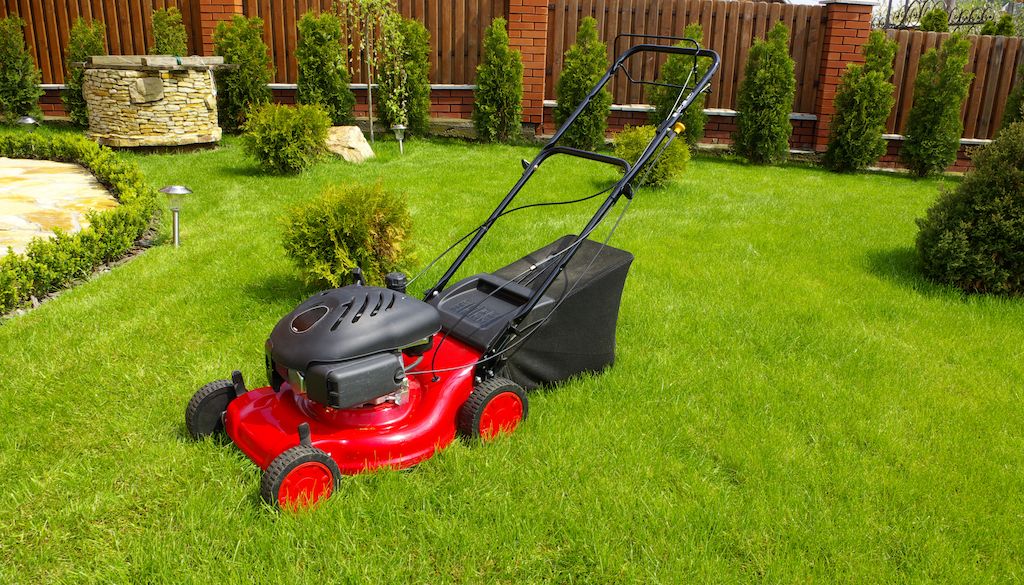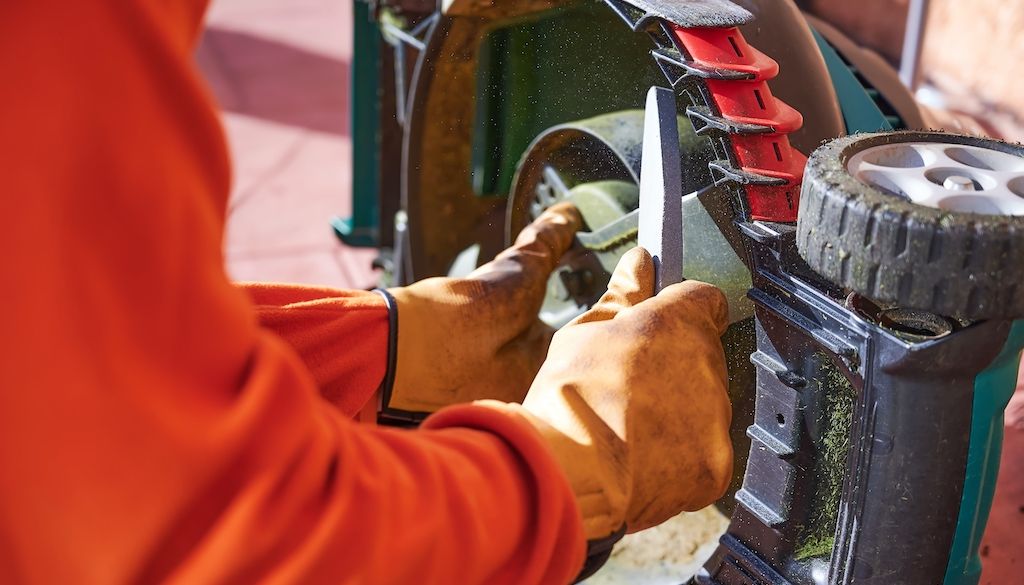Why is lawn mowing important?
Mowing your lawn is the essential first step to getting an amazing yard. If you want a lawn you can be proud of when people visit, you need to cut your grass regularly.
Lawn mowing also eliminates pests that could destroy your grass. Frequently mowing your lawn helps the grass blades multiply — improving the overall health of your yard. Think of it as something similar to giving your hair a regular trim.
When and how often should I mow my lawn?
Your lawn mowing schedule depends on where you live, the weather and the type of grass you have in your yard. The amount of water and fertilizer your lawn gets also affects its growth rate.
See the table below for a quick breakdown of the types of grass, examples and mowing schedule per growing season:
Grass type | Grass species | Mow when the grass reaches… | Set your mower to… |
Cool season | Annual ryegrass | 2.25-3 inches | 1.5-2 inches |
Warm season | Bermuda | 1.5-2.25 inches (for seeded bermudagrass) .75-1.25 inches (for hybrids) | 1-1.5 inches (for seeded bermudagrass) 0.5-1 inch (for hybrids) |
Warm season | Buffalograss | 1.5-3 inches | 1-2 inches |
Cool season | Colonial bentgrass | .75-1.5 inches | .5-1 inch |
Cool season | Creeping bentgrass | .75 inch or less | .5 inch or less |
Warm season | Dichondra | .75-1.125 inches | .5-.75 inch (can remain unmowed) |
Cool season | Hard fescue | 3.75 inches | 2.5 inches |
Cool season | Kentucky bluegrass | 2.25-3.75 inches | 1.5-2.5 inches |
Warm season | Kikuyugrass | 1.5-2.25 inches | 1-1.5 inches |
Cool season | Perennial ryegrass | 2.25-3.75 inches | 1.5-2.5 inches |
Cool season | Red fescue | 2.25-3.75 inches | 1.5-2.5 inches |
Cool season | Rough bluegrass | 1.5-3.75 inches | 1-2.5 inches |
Warm season | Seashore paspalum | 1.125-2.25 inches | .75-1.5 inches |
Warm season | St. Augustine | 1.5-3 inches | 1-2 inches |
Cool season | Tall fescue | 2.25-4.5 inches | 1.5-3 inches |
Warm season | Zoysia | .75-1.5 inches | .5-1 inch |
Source: Agriculture and Natural Resources, University of California
There are a few ways to tell if your lawn needs mowing:
- Walk on it. If it is soft and spongy underfoot, the grass is too tall and needs mowing. At the right height, the grass is firm and springy.
- Check the grass height. If it's more than 3 inches tall, it's probably time to mow.
- Check the grass color. If it starts to turn brown or yellow, you need to mow your grass.
If you aren’t sure what kind of grass you have, ask a lawn service professional to help you identify it. They’ll also know how to help ensure it stays healthy and lush throughout the year. Check out our spring, summer and fall lawn care guides for more tips.
What you need to mow your lawn.
If this is your first time mowing your lawn, check the list of tools below for what you will need:
- Lawnmower
- String trimmer
- Edger
- Gloves
- Rake
- Bag
 Before getting a lawn mower, research which is best for your yard. You’ll find many different kinds, including:
Before getting a lawn mower, research which is best for your yard. You’ll find many different kinds, including:
- Walk-behind mowers or push mowers
- Rotary mowers
- Power mowers
- Compost pile-powered mowers
- Gas-powered mowers
- Riding mowers
- And more
You may even want a mulching mower to cut the grass clippings before spreading them across your lawn.
Pro tip: If you have grass that's more than 1 inch high, consider using a rotary mower. mowers are better for cutting grass above 1 inch high. Reel mowers are better for cutting grass that's shorter than 1 inch.
How to mow your lawn in 4 steps.
Mowing your lawn is a simple task. See below for the step-by-step guide:
Step 1: Dress appropriately.
Accidents can happen if you don’t take the necessary precautions. Wear closed-toed shoes when mowing your lawn to keep your feet safe from any accidents. Put on a pair of gloves to protect your hands from the elements and sharp objects.
Step 2: Remove debris from your lawn.
Before mowing, remove any debris that could cause problems for your mower or become a safety hazard. These include trash, sticks, rocks and larger debris your mower can't mulch.
Step 3: Work in rows.
Set a direction for mowing your lawn. If you don't, you may miss a spot or keep mowing over the same patch repeatedly.
Divide your yard into rows and go over it one at a time, no matter the size of your lawn. Plot out where you'll start and end, passing over each row by several inches so you have your entire yard covered.
If you have an irregularly shaped lawn, break it up into sections. Cut the outside perimeter first, then proceed to mow in straight lines.
Pro tip: If your yard is huge, you may want to consider getting a riding lawn mower to cover more ground. That way, you won't tire yourself out by pushing your mower.
Step 4: Trim the grass along the edges.
After mowing your lawn, don’t forget to trim the edges or the ones where the mower doesn’t reach. This may include edges next to trees or shrubs.
Match the height of the grass there to the size you just mowed. This way, you don’t accidentally scalp your grass, allowing more weeds to come out.
Lawn mowing tips and mistakes to avoid.
 Mowing takes patience and practice. Every time you mow, keep the following tips in mind:
Mowing takes patience and practice. Every time you mow, keep the following tips in mind:
1. Remember the "one-third" rule.
When you mow your lawn, you should only remove a third of the visible grass height. Cutting the grass at the right height improves the root system of your lawn.
Mowing too short (called scalping) will result in weaker grass that will take longer to recover. This can make your lawn more vulnerable to weed seeds. It will also have more sun exposure, which increases the chance of germination.
2. Keep your mower blades sharp.
Dull blades leave jagged edges on the grass, making them more vulnerable to diseases. When you have cleanly-cut blades, the grass can conserve water better.
3. Don't mow when the grass is wet.
Wet grass sticks to the mower blades and clogs the mower. If it rained overnight or you just watered your lawn, wait for the grass to dry before mowing. Mowing wet grass also causes clumping and ruts, making your lawn more susceptible to diseases.
4. Maintain your mower.
Make sure your mower is in top shape all the time. In addition to sharpening the blades, make sure you dry them when they're wet. It’s also a good idea to have extra blades on hand.
Hire a lawn care service on Thumbtack.
Is mowing beyond your time and energy? Download the Thumbtack app and hire a lawn care service to take care of your grass.
Related: How much do lawn services cost?
FAQs
Should grass clippings be left on the lawn?
Leaving grass clippings on your lawn, also called grasscycling, allows the grass’ nutrients to return to the soil. It can also protect your garden against fungal diseases. If your grass is too long, mulch it first by cutting it several times or rake them off instead.
Do you edge or mow first?
What is the best time of the day to cut grass?
Should you mow your lawn in different directions?
When mowing your lawn, work only in one direction so you don't end up matting your grass. However, it’s good practice to switch directions whenever you cut grass.
Grass blades often grow in the direction you mow them. Varying the pattern will push them back to a more upright position.
A note about project costs included or linked in this article: Figures represent national average cost estimates using data provided by Thumbtack pros and additional research. These figures are provided for educational purposes only and are subject to change at any time due to various factors. Details about your specific project and local rates can impact costs.